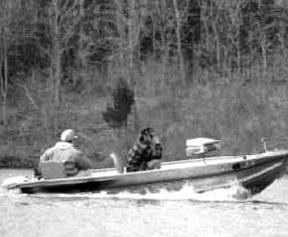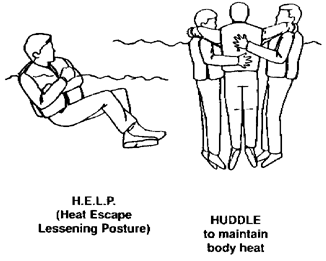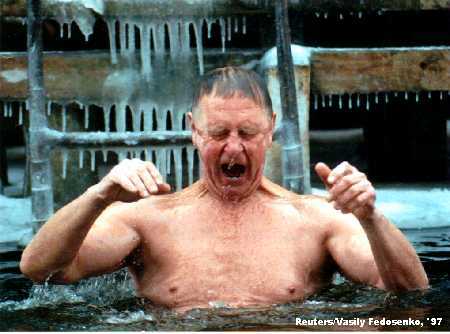

The risk of falling overboard or capsizing may be small, but the threat-to-life of such accidents is most serious.
There are no crowds of boaters on lakes and rivers in the colder months of the year. Fishermen work their favorite coves nearly undisturbed. On inland waters, migrating waterfowl appear in the fall and return again in the spring as soon as the ice goes out. The fine, breezy days of spring and fall are the best of days for many open boaters. There are trade-offs for these blessings. The water is cold (less than 60 degrees F) in the off-season. More than half of the fatal boating accidents in Pennsylvania occur when the water is cold. Most such accidents occur in calm weather, relatively close to shore. Because fewer boaters are on the water, the likelihood of a prompt rescue is greatly reduced. Off-season boaters must be as self-sufficient as possible.
Immersion in cold water rapidly incapacitates and may kill boaters who are not wearing protective clothing. Surfers, sailboarders, and river paddlers wear wet suits or dry suits when the water is cold. Off-season sailors, fishermen, hunters, and other folks out in open boats can use these same precautions to greatly improve their safety on the water.
What happens in cold water?
Cold water removes heat from the body 25 times faster than cold air. About 50% of that heat loss occurs through the head. Physical activity such as swimming, or other struggling in the water increases heat loss. Survival time can be reduced to minutes. Strong swimmers have died before swimming 100 yards in cold water. In water under 40 degrees F, victims have died before swimming 100 feet.
Cold Shock
Hypothermia
Hypothermia (decreased body temperature) develops more slowly than the immediate effects of cold shock. Survival curves show that an adult dressed in average clothing may remain conscious for an hour at 40 degrees F and perhaps 2-3 hours at 50 degrees F (water temp.). The crisis is more serious than these numbers suggest. Any movement in the water accelerates heat loss. Survival time can be reduced to minutes. Hands rapidly become numb and useless. Without thermal protection, swimming is not possible. The victim, though conscious, is soon helpless. Without a life jacket, drowning is unavoidable.
Even with a wet suit/dry suit on, one's hands rapidly become useless in water in the low 40's degrees F. Protective fingerless gloves for fishermen can be important. Shivering occurs as body temperature drops from 97 degrees F down to about 90 degrees F. Uncontrolled rapid breathing follows the initial gasping response and may cause loss of consciousness. The victim must attempt to recover control of his/her breathing rate.
Muscle rigidity and loss of manual dexterity, physical helplessness, occurs at about 93 degrees F. Mental capacity also deteriorates at this point.
Unconsciousness occurs when the body's core temperature reaches about 86 degrees F. If drowning doesn't occur first, death occurs at a core temperature of about 80 degrees F.
How Fast Can it Happen?
On Memorial Day, 1996, an 18-year old canoeist capsized into 50 degrees F lake water. He sank to the bottom before a rescuer in a boat towing the canoe could reach him. He was wearing blue jeans, a light shirt and no life jacket. His body was recovered the next day by divers. Your ability to survive accidental immersion will depend on how you prepared yourself before going out.
Dressing for the possibility of immersion helps buy time to work out a rescue in case of an accident. Warm weather does not cancel out the danger of cold water. Instead, wearing lighter clothing on warm days may increase risk.
Once in the water
Try to get back in or on your boat immediately. Do not leave the boat. If you are not wearing thermal protection and can not get out of the water, stay as still as possible. Fold arms, cross legs and float quietly on the buoyancy of your PFD until help arrives (Heat Escape Lessening Posture; H.E.L.P.). If 2 or more people are in the water, put your arms around one another. Stay still and close together (Huddle posture).

Treatment of Hypothermia
Planning Ahead
Wear clothing that permits safe cold-water immersion and a life jacket. It is the only way to combat the risk posed by cold-water boating.
The common advice to wear layers of wool (nylon, polypropylene) is misleading. These fabrics do not effectively retard heat loss in cold water. They are warm when damp, after being wrung out, due to air trapped in the fibers. They must be worn inside a waterproof barrier (shell) having neoprene or latex gaskets at ankles, waist, wrists and neck. Fleece-lined "wetsuit grade" polartec clothing is rated equal to 2.5 mm neoprene and is comfortable under outer clothes. Such clothing ($100-300) may be found in catalogs & shops that serve river paddlers and windsurfers).
Carry dry clothing in a water proof bag. Tie a bailer and paddle to your boat. Evaluate the flotation in your boat. A short sling tied to the transom, with a foot rest in the loop, may assist boat reentry. Attach a whistle or horn to your life jacket.
Tell someone where you are going and when you will return. Inform them of your return. Check the weather forecast for the day.
WATCH THE BOATS AROUND YOU. On cold water, you are depending on one another for prompt rescue in case of an accident.
© Charles Sutherland 10 February 1997
Please address comments to:
Charles Sutherland 2210 Finland Rd. Green Lane, PA 18054
 Main Page |
Here are a few ways in which boaters have been ejected from their boats. A man in a 12 ft open boat hit a wave and was thrown over the side by the impact. A shad fisherman, sitting in a lawn chair in an open boat, lost his balance and fell overboard. A fisherman casting from the bow of an aluminum boat had one foot slip and suddenly fell over the side. Canoes in rough water capsized. Perhaps the paddlers were sitting boldly erect on the canoe seats. Two canoeists on a small, calm lake at dusk capsized for no obvious reason. Three men in a rowboat on the fast moving Delaware River caught their anchor on the bottom. In trying to jerk it free, one of them pulled the bow under. The current instantly took the boat to the bottom of the river. Two of the men made it safely to shore.
When hit by a powerful wind gust on a sunny, windy day in April, a man lost his balance and fell overboard. By luck, his life was saved. His arm was hooked through a safety line which kept his face out of the water. Although completely paralyzed by the cold, he did not drown. He was dressed in street clothes with no PFD.
These boaters never intended to engage in an Extreme Sport. They were not offshore in a great winter storm. They didn't set out to defy death by kayaking over waterfalls. These were ordinary folks, taking a break from the daily grind of life. The extreme danger posed by cold water boating is seldom driven home to the boating public.
The effects of cold water on the head and chest can render you unconscious instantly, although this outcome seems to be uncommon. The momentum of an individual falling overboard usually drives the victim under the surface for several seconds. Exposure of the head and chest to cold water causes involuntary gasping (photo). When the victim is not wearing a life jacket, the gasping may occur under water. In some cases, cold water is drawn into the lungs, in others, the muscles controlling airflow into the windpipe (trachea) close and stay closed. Either outcome prevents effective breathing when the victim surfaces. The victim, now unable to breath, is last seen struggling briefly at the surface before disappearing from view. Press reports tell us that the boaters drowned, leaving the impression that they just didn't know how to swim. BEING ABLE TO SWIM IN THE WARM WATERS OF SUMMER HAS NOTHING TO DO WITH SURVIVAL IN COLD WATER.
 Cold water immersion gasping reflex. |
Survival tables suggest that a victim may survive for a relatively long time in cold water (40-50 degrees F, 1-3 hrs). These tables are only valid if the victim is wearing a life jacket. Without the flotation of the life jacket, the victim is forced to swim, which drastically accelerates heat loss, onset of paralysis, and drowning.
On March 6th, 1968, nine elite marines, trained as water survival instructors at the Marine Corps Physical Fitness Academy, capsized while paddling a war canoe across the Potomac River. They wore sweat suits. They had seat cushions but no life jackets. The water temperature was 36 degrees F. None of these men were able to swim the 100 yards to shore. This is the bluntest of messages for all of us.
These disasters are easily preventable. Wearing a life jacket would have saved many of these boaters. It seems clear that nothing will convince boaters to wear wetsuits or drysuits on their cold water boating trips. Now, in the age of high tech everything, there is a new fabric out there. Polartec 2000 has a comfortable, fuzzy inner layer and a double membrane outer layer. Because that outer layer prevents rapid movement of water through the material, the Polartec 2000 behaves like a wetsuit and is rated equal to 2.5 mm neoprene. If boaters at least wore Polartec 2000 garments under their boating clothes, and life jackets, deaths in cold water boating accidents would become rare events.
I capsized in 51 degrees F water in April, 1997 and spent about 10-15 minutes struggling in the water. I was wearing a long sleeve top and long pants made of Polartec 2000, and a life jacket. A friend came back for me. We bailed out my boat, and then continued sailing without ever shivering. We have numerous cases of boaters dressed only in street clothes falling into 50 degrees F water and drowning within a few minutes. Their bodies are subsequently retrieved by rescue squad divers who risk their lives, often for many days in a row, to get the job done. Such searches cost massive amounts of money.
Boaters wearing life jackets when they go over the side do not sink as far under the water before bobbing back to the surface. Their heads may not go under at all. The devestating effects of the cold on head and chest are greatly reduced. Even if they inhale some water, they still have some chance of survival because they won't immediately sink. With the minimal protection of the life jacket and the wetsuit-like Polartec 2000 outfit, boaters have the possibility of improvising their own rescues. Such clothing is comfortable, inexpensive, and readily available from merchants serving paddlers and windsurfers. If family members truly understood the risk of cold water boating, would boaters still go out dressed in just t-shirts and blue jeans? The clothes that keep us warm in the woods are useless in the water. Check out these recent accidents.
Saturday, April 4, 1998, David G. Erbacher, 19, and Matthew Korilko, 18, took a canoe out on Lake Somerset in Somerset Center, Michigan. They were students at Bowling Green State University. After paddling for about two hours on the man-made lake, they capsized about 200 yards from shore a little before 2:00 pm in the afternoon. They were not able to swim to shore. A fraternity friend, Neil Kessel said, "The way I heard it is that one of them went under, and the other went to help and he went down too." The two young men were friends that had been together on their Madison High Scholl wrestling team.
They did not take life jackets or other flotation devices with them when they set off in the canoe. There bodies were recovered by divers the next day, Sunday, in 10-15 feet of water. The water temperature was reported to be 46 degrees F. The weather conditions for that Saturday were not reported.
Abstract of a report from the Toledo Blade webpage. The accident was reported in the April 6, 1998 edition of the Blade by Mike Tressler, Toledo Blade Staff writer.
On Saturday, February 14, 1998, Damien Mahr, 27, and Rodrigo Olivares, 27, borrowed a 12 foot canoe and went paddling on Manhassett Bay, Long Island Sound, off Manorhaven, NY. The wind was blowing pretty hard that day. They capsized about 300 yards off Plum Point (Manorhaven). The water temperature was about 40 degrees F. They were not equipped with life jackets or any other cold water boating gear. Mr. Olivares was able to turn the canoe rightside up and get back in it. When he was rescued nearly an hour later, Constable Jim Flemings said, "He couldn't move at all but told us, I think my buddy's dead." Mr. Olivares appeared to be unaware of what became of his friend. Mr. Mahr was still missing on Monday, February 16. The search operation included Nassau police department divers, about a dozen government and private boats and two police helicopters.
Information abstracted from Nassau and Suffolk edition of Newsday for Sunday February 15 and Monday February 16, 1998 by Staff Writers Emi Endo and John M.Gonzales.
On March 28, 1998, Mike Vanderwoude, 37, took two friends out on Van Sciver Lake near Tullytown, PA. He returned them to shore and the went back out alone. The wind was blowing making, rough conditions on the lake. He capsized and, while trying to swim back to his boat, he drowned. Rescue divers recovered his body about an hour later. The water temperature was in the vicinity of 45 degrees F.
The Philadelphia Inquirer, Sunday, March 29, 1998 section B2.
November(?), 1997. Two adults and a 9-yr-old boy died in Moosehead Lake (Rockwood, Maine) when their heavily loaded, 15-ft canoe capsized. Their bodies were found the next day. They were all wearing life jackets, but were unable to swim to shore. There were no other boats in the vicinity at the time of the accident. The water temperature was 50-55 degrees F. The victims drowned as a result of hypothermia.
November 23, 1997. Two college students took a canoe out at dusk on Lake Panamoke on Long Island, NY. The lake is about a half-mile wide. The young men capsized in the middle of the lake shortly after 5 p.m. Their calls for help were heard on shore and two near-by residents paddled a row boat out to rescue them. By the time the rescuers reached the overturned canoe, one of the victims had disappeared. His body was recovered in 10 feet of water at about 6:45 pm. The other paddler survived thanks to the rescuers. The water temperature was about 45 degrees F. The paddlers were not wearing life jackets and were not carrying them in the canoe.
(NY) Newsday; Nassau/Suffolk Edition, Monday November 24, 1997. by staff writers Andrew Metz and Tom Demoretcky.
(Note that even though weather conditions were apparently calm, the victim was not able to hold onto the capsized canoe until help arrived. I don't know how long it took for the rescuers to reach the canoe. CAS)
KAYAKING ACCIDENTS
Volunteer fire fighter, Kendall Bryant, 32, died on the Etowah river, Georgia, on Saturday, February 28, 1998 (air 65 degrees F, water 45 degrees F, class 0-1 water, but very powerful high-water current). He capsized on a small wave, came out of his kayak, struggled to get on it for a few seconds and then disappeared. Cold shock undoubtedly caused gasping while he was submerged. Mr. Bryant went under for the last time less than 30 seconds after capsizing. Last I heard, his body had not been recovered. The extreme danger of submerged snags precluded the use of dive teams. His friends described him to the press as experienced. He was wearing a T-shirt, cotton pants and no PFD. He refused to wear a PFD, leaving it in his truck the day he died. He had no flotation in his boat, hence it could not support him when he initially surfaced. His submerged craft was recovered with grappling hooks four days after the accident.
On Sunday, March 8, 1998, Kansas City, Missouri experienced a serious winter blizzard. That same day, at about 4:30 pm, David Grizzell Jr. took his kayak [river or sea, not indicated] out on Lake Winnebago located just south of Kansas City in Cass County. At 5:55 pm authorities were told that Mr. Grizzell had capsized and was in the water. He was about 25 yards from shore when one of the fire fighters put on a wet suit and attempted to reach him. He tried to throw a line to Grizzell but the wind just blew it back. One report had it that Mr. Grizzell was trying to pull his boat to shore. The water temperature was 35 degrees F. The rescue was complicated by high winds, snow and high waves. The fire fighters were unable to launch an aluminum fishing boat because of the waves and wind [must have been an onshore wind]. Fifteen minutes after the rescue began Mr. Grizzell went under. His body was recovered two days later by divers.
Mr. Grizzell was a dentist with several offices around the area. He had been paddling on the lake all winter. He was wearing a light jacket, blue jeans, and sneakers at the time of the accident. He was not wearing a life jacket. What lead him to go out on the lake in the storm was not indicated. Phil Brillhart, a South Kansas City Metro District assistant chief said he believed that Mr. Grizzell was overcome by hypothermia. That would be a substantial understatement.
Abstracted from articles in the Kansas City Star by Staff Writers Gita Sitaramiah (3/11/98) and Matt Campbell (3/10/98).
Expert Cold Water References
 Main Page |